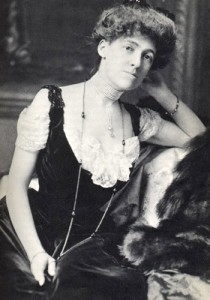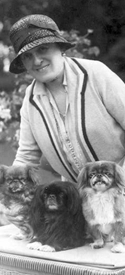Edith Wharton was an American novelist, short story writer, landscape Architect and Interior designer who lived from 1862-1937. She is the first woman to win the Pulitzer Prize for literature for her novel ”The Age of Innocence” in 1920. Wharton was a prolific writer who has left an accomplished treasury of work, including 40 books. She is known for presenting personal relationships with depth and sensitivity during the end of the Victorian era. There is often a consciousness and perception in Wharton’s work that goes beyond conventional moral positions.
Wharton was an authentic ”blue blooded” aristocrat whose parents had aquired and inherited enormous wealth from shipping, banking and real estate interests during the gilded age of mercantilism following the U.S. Civil War. The popular expression, ”keeping up with the Jones’s is thought to have referred to her mother Lucretia’s side of the family. Wharton wrote from the perspective of a particular segment of the Amercian experience, known as ”old money” which upheld the status quo and social mores and taboos that both insulated the class, yet made its survival more precarious.
” Her characters…, are some of the most memorable in American literature. Often portrayed as tragic victims of cruel social conventions, they are trapped in bad relationships or confining circumstances. Her own life stands as an example of the obstacles that a woman of her time and place had to overcome to find self-realization.”
Wharton owes some of her literary success to writing about universal themes in a profound and accessible manner while avoiding political issues. Identity was interpreted as the conflict between acquiescing to society’s established roles and the individuals desire to have opportunities to exercise free will. This was a personal source of anguish for Wharton between balancing the social role of wealthy matron with a desire to realize her potential as a writer. In addition, she wrote of a wealthy American subculture as a passing civilization, a disintegrating ”ethnic” enclave being bypassed by a newer, modern age both technologically and structurally such as through the new Federal Reserve banking system. Her work almost has an anthropological value to it. The innocence of the new world, paralyzed by their own materialism and ethnocentrism, underestimates the conflict with the Old World and their application of corruption and wisdom in a determined attempt to to assert its claim over a share of America’s wealth.
Wharton was greatly influenced by writer Henry James whose innovative development of ”literary realism” within a novel allowed Wharton to adopt part of those conventions within her own feminine mystique. James’s style of writing from the point of view of the character expanded the potential for character development in the work of Wharton by introducing elements of psychology and the exercise of power through the interpesonal. This was somewhat akin to what Henrik Ibsen had achieved through his realistic dramas. Like Ibsen, Wharton was able to convey some disquieting
ities surreptitiously hidden behind the veneer of late Victorian era respectability.






 COMMENTS
COMMENTS
I think i’ve seen this somewhere before…but it’s not bad at all
Thanks,
Not a bad post on my part. Hard to nail down the Gettysburg address each time out. Lots of complex threads in her story for a short post. Makes me think of Emily Bronte and Jane Austen to some extent.